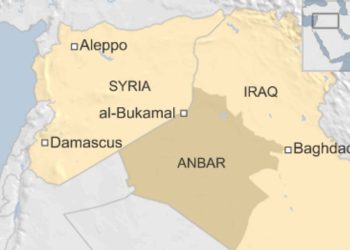BACKGROUND: This article builds on two major works by two thinkers in the Salafi-Jihadist movement. The first is “Fursan Tahta Rayat An-Nabi” (Knights under the Prophet’s Banner), by Ayman Zawahiri, was published as a series in the London-based Arabic newspaper “Al-Sharq Al-Awsat” in December 2001. The second is “Al-Muslimoun fi Wasat Asia wa Ma’rakat Al-Islam Almukbila” (Muslims in Central Asia and Islam’s Next Battle), by Abu-Mus’ab al-Sori “the Syrian” in November 1999 and published on many Islamist free websites. Zawahiri is a well-known figure, and Abu Mus’ab al-Sori is a Salafi-Jihadist ideologue who conducts research to “review the Jihadist experience and explore the methods and patterns of Jihadist movements” and was not involved in the movements’ activities until the American Department of State issued a warrant for his arrest in 2004 with a US$5 million reward, which “the Syrian” described as ridiculous. Zawahiri and al-Sori both agree that there is a global movement, exemplified by the “Crusader-Zionist alliance”, against Islam and its proponents, namely the Jihadists. Therefore, they believe in the necessity of finding a safe haven for their movement, as other Salafi-Jihadist movements seem to believe, to be a base for their constant and expanding battle against the United States, Israel and other enemies of the Muslim World. Central Eurasia, according to those two leaders, is the base from where Jihad will move towards the Heart of the Muslim World, that is the Middle East, which Zawahiri claims “represents the true battlefield, the stage for the major operations and the base for Islam”. Al-Sori is of the same mind; arguing that “in the present stage, it is necessary for cadres of Islamic work in general to join forces with Jihadist movements in the region [Central Asia] to carry their Jihad there and then move on to the Middle East.” In that context, Eurasia is of temporary significance until the battle is moved to the Heart of the Muslim World. This can be achieved by forming a “Jihadist Islamic belt”, as Zawahiri calls it, that can be created by recourse to the Chechnya and Afghanistan experiences by hand and by mouth, but without implicating them by force or pressure given the many conditions surrounding these two areas.
IMPLICATIONS: Zawahiri believes that Chechnya and Afghanistan (with a liberation Jihadist movement in each one) is a threat to American interests because of the tremendous amounts of oil in the area and the presence of American forces in Central Asia. He also believes that the success of the Chechen experience in “liberating the Caucasus” will “form a Jihadist center that will harbor thousands of Mujahideen from all over the Muslim World in a way that facilitates their passage to the Caspian Sea, which is rich in oil, leaving between them and Afghanistan only the neutral Republic of Turkmenistan, thereby creating the Jihadist Muslim belt in the South of Russia and reaching Pakistan, with its young Mujahideen in Kashmir, in the east and Iran and Turkey, who are sympathizers with Muslims in Central Asia, in the south and west. Zawahiri sees in that the destruction of Russia, which he dubs a United States ally, in the face of a “Jihadist awakening”, which he believes is the reason the United States is not interfering to stop Russian crimes in Chechnya. Al-Sori’s perspective is not very different from Zawahiri’s, except that he believes there are buds of a Jihadist movement in Uzbekistan. He feels that Jihadists’ taking control of or creating a safe haven in the area from Bangladesh to North India, Kashmir, Pakistan, Afghanistan, Central Asia with the Muslims of Turkmenistan, to the Caucasus and Urals, which is geographically spacious and has a significant Muslim presence, lends leverage to the activities of the “Jihadist movement.” In addition to that, al-Sori adds a number of religious and theological justifications for the area’s importance, such as citing indications in the Prophet’s sayings that point to Islam’s coming victory in the area. These are in addition to political and strategic reasons, such as the region being a point of strength for Muslims and a point of weakness for the “Crusader-Zionist alliance”. Al-Sori also sees additional advantages in the population density and geography because the area will be an “invincible fortress for Jihadist movements.” The same goes for economic resources that will provide the “Jihadist movement with financial support.” Diffusion of the Salafi-Jihadist stream in the region is distributed across different historic eras, especially Tajikistan, Chechnya, and the Ferghana Valley straddling Uzbekistan, Tajikistan, and Kyrgyzstan. It thus shoots out in a parallel line with other regions where the stream has been active, including Afghanistan, Pakistan, the Middle East, and Turkey. The stream seeks to establish a safe haven in the region so as to establish a base from which it would launch “Jihad”, safeguarding its continuity, either in facing the United States, its interests in the Middle East, or the ruling regimes there. This would form a platform to establish some type of a southern front, utilizing the natural resources of the Caspian region and the region’s marine outlets at the Caspian Sea (which Afghanistan lacked) in addition to benefiting from the state of anxiety faced by Eurasian communities stemming from the economic and social transition processes. The presence of oil pipelines in the region is yet another factor whereby they are envisaged as keys to control of the flow of oil, and may pose a genuine threat to many countries in case the Salafi-Jihadist forces flourish in the region.
CONCLUSIONS: The Salafi-Jihadist movement aims at finding safe havens to be the base for its “Jihadist” activities. The existence of such a haven illustrates the salvationist nature of the movement that moves between the “far enemy” and the “close enemy.” Moreover, the Salafi-Jihadist movement strives to create safe havens in areas that possess a strategic resource, like oil (Iraq, Saudi Arabia and Central Asia) in order to form a geopolitical front that challenges America’s presence, allies, and interests. The war in Iraq has paved the way for a new front for the Salafi-Jihadist stream, indicating a retreat in the priority accorded to the Caucasian and Central Asian region. However, the region remains vulnerable to renewed activities, particularly as it faces structural problems that the Salafi-Jihadists regard as fundamental in gaining acceptance for their views and trends. These include a high level of oppression and domineering regimes, high corruption and unemployment, and Russian attempts at hegemony. Therefore, any changes in the Iraqi situation would keep Central Eurasia a good candidate for an increasing presence of the Salafi-Jihadist forces there. Of course, the causes and interests of the peoples of those areas remain different from the agenda of the Salafi-Jihadist movement; Chechnya is probably the best example of that.
Source: Central Asian Caucasus analyst











